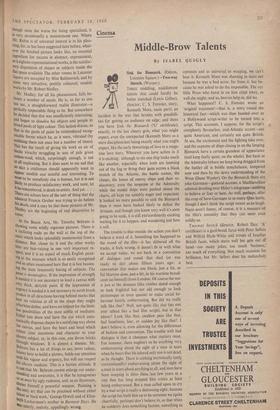Art
The Fancy
By SIMON HODGSON
THE pictures Mr. Sam Rabin is showing at the Leicester Gal- , leries are almost exclusively of boxers and boxing. At first sight they are too cleverly organised, too smartly dramatic and rely- ing too readily on extreme angles of vision. But this is illu- sory, for there is in these paintings both consider- able discipline and, which is rarer, an entirely immediate sense of participation and excitement. The smallish canvases are organised very simply, and Mr. Rabin's effects are built on things as simple as the ropes of the ring cutting formal patterns across the smoky darkness of the arena. This is his chosen subject-matter—he was a boxer —and he knows it so well that he seems unable to miss its atmosphere in any one of these works. Look also at his paint. He uses it, and colour, with restraint, except sometimes when he over- dramatises the hard light on a boxer's shoulder and upper arm, but he also loves it, works it, and leaves it with a'texture exactly suited to his mood. This, in short, is a painter illustrating something he knows, and about which he remains continually curious, using paint as a respected tool, and organ- ising his canvases, within the representational idiom, as two-dimensional objects. This highly determined and disciplined art descends largely from France, and we have heard of Mr. Rabin's admiration for Despiau, but it descends. via Sickert, the friend of his master Tonks; indeed Sickert is an unavoidable influence for those who continue, in this country, to work in representa- tional terms, but are Still aware of recent move- ments; but it is a specialised derivation, and, though none the worse for being specialised, it is very occasionally a monotonous one. Where Mr. Rabin is of universal interest is in his plan- ning, for, as has been suggested here before, what- ever the finished picture looks like, an essential ingredient for success in abstract, expressionist, or Leighton-representational works, is the satisfac- tory disposition of shapes or subjects inside the fiat space available The other rooms in Leicester Square are occupied by Miss Rabinovich, and by some very attractive, prettily coloured, modish works by Mr. Robert Medley. Mr. Medley, for all his pleasantness, falls be- tween a number of stools. He is, so far as one can see, a straightforward realist illustrator—a Perfectly respectable thing to be. But somewhere he decided that this was insufficiently interesting, and began to dissolve his objects and people in broad pools of light colour. This lacked drama, so that in the pools of paint he reintroduced recog- nisable forms which he, as it were, vibrated (by outlining them not once but a number of times). This has the result of giving his work an air of hectic vivacity struggling in seas of pale green cotton-wool, which, surprisingly enough, is not at all unpleasing. But it does seem to me sad that 80 nice a craftsman should apparently want to apPear modish and tasteful and interesting. To Want to be somebody else is human, but it is not airelY to produce satisfactory work, and taste, let it be remembered, is death to artists. And yet. . . . There are echoes here of the sort of thing that the admired Francis Gruber was trying to do before his death, and it may be that these pictures of Mr. Medley are the beginning of real discoveries to Come.
At the Beaux Arts, Mr. Timothy Behrens is showing ng some wildly vigorous pictures. There is a reclining nude on the wall at the top of the stairs which looks splendidly monumental from a distance. But, closer to, it and the other works here are hair-raising in one very important re- spect, and it is an aspect of much English paint- ing at the moment which is so easily recognised and so often mentioned here that it is fast becom- ing the most tiresomely boring of subjects. The Paint is meaningless. If the impression of strength is needed it is not necessary to load a canvas with very thick, dirtyish paint. If the impression of urgency is needed it is not necessary to scrub brush strokes in all directions leaving behind marks that bear no relation at all to the shape they might otherwise define, and have no respect for the limit- less possibilities of the most subtle of mediums. Either you draw and have the eye which auto- matically disposes shapes in a satisfying way about the canvas, and have the heart and head which relates your intentions and character to your chosen subject, or, in this case, you throw bricks through windows. It is almost a disease. Mr. knows has a lot of things to say, loves colour, snows how to build a picture, holds our attention with his vigour and urgency, but will not respect his s chosen medium. This is a barren attitude. It Is not that Mr. Behrens cannot enlarge our under- standing and awareness, it is that he antagonises us at once by ugly rudeness, and, as an illustrator, ,_ ales himself a powerful weapon. Tainting is tue only art that can be practised without either .talent or hard work,' George Orwell said of Eliza- beth Lackersteen's mother in Burmese Days. He Was utterly, entirely, appallingly wrong.







































 Previous page
Previous page